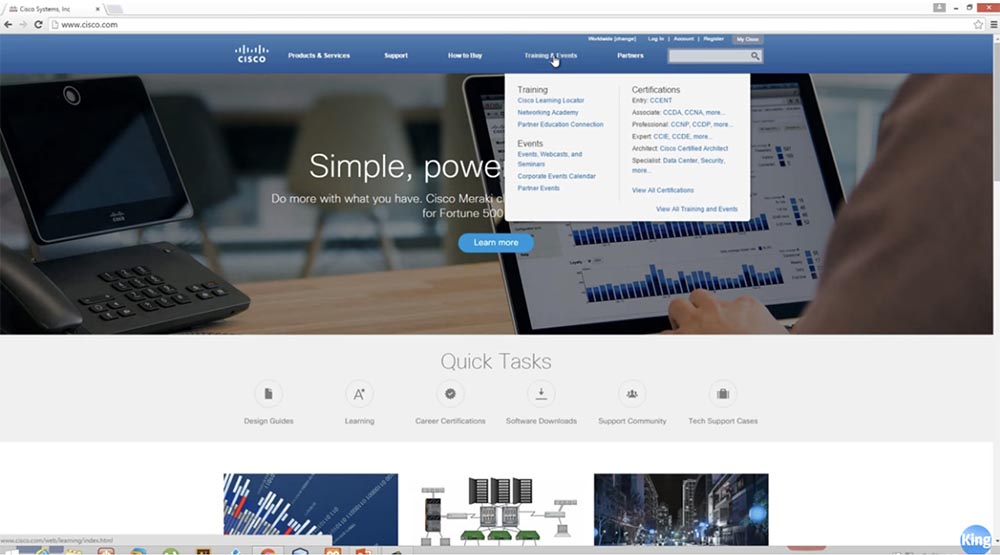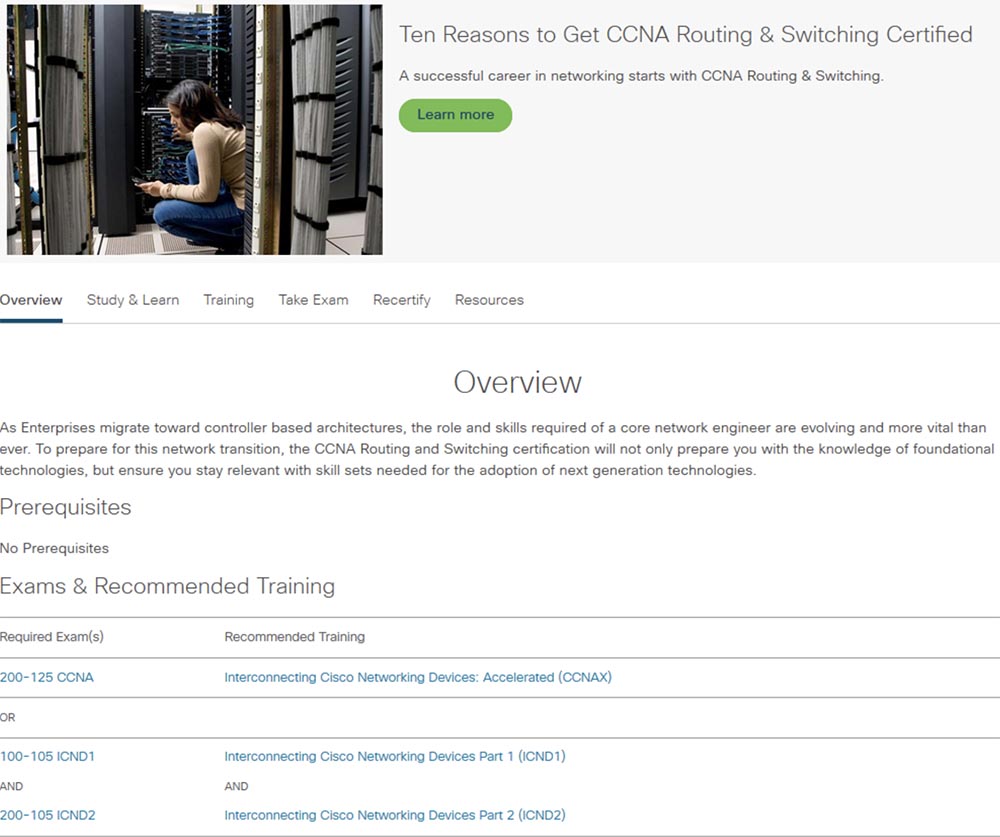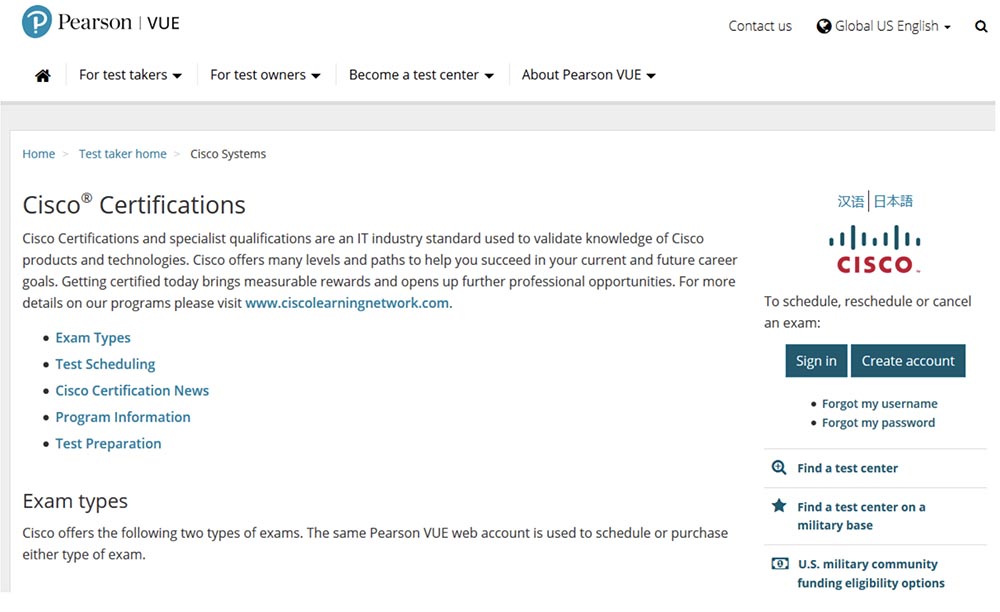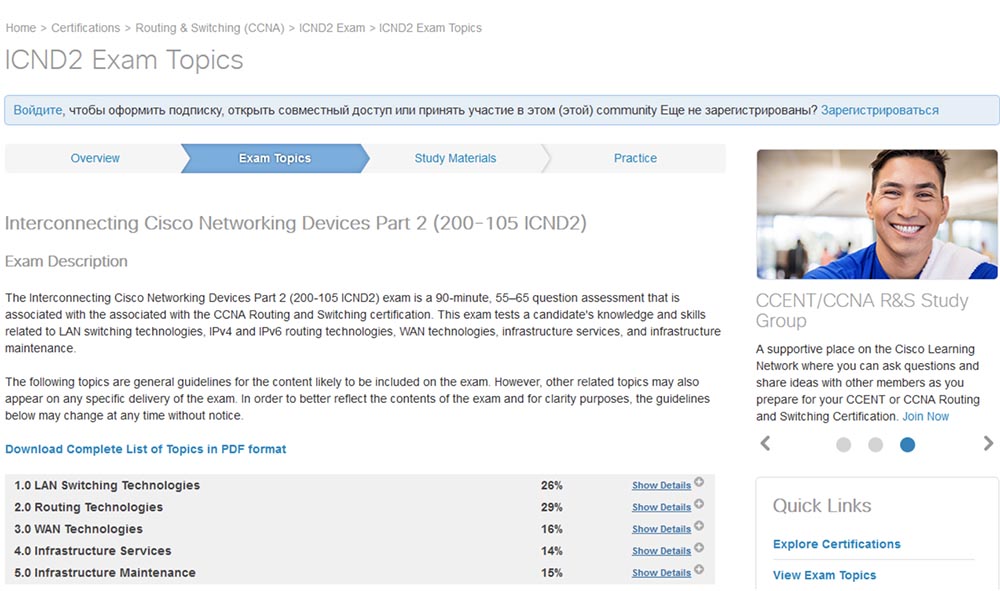Training Cisco 200-125 CCNA v3.0. Day 17. Summary and roadmap of CCNA course
Today we will summarize our training and consider what we will study in the remaining series of video tutorials. Since we use Cisco training materials, we’ll visit the company’s website at www.cisco.com to see how much we have learned and how much remains before the course is completed.

Translator’s note: there have been changes in the design of the Cisco website and the content of exams since the video was posted on 11/28/2015, so the following screenshots show the site’s appearance as of 04/13/2019, and the text of the lecture has been updated.

In order to view the course materials, click on the Learning Locator link and go to the Training & Events page.

Next, on the Training & Events page in the right menu, select the Cisco Certification link.

On the Cisco Certification page, you can find all Cisco certificates, grouped by professional level: Entry (Technician), Associate (Professional), Professional (Expert), Expert (Expert) and Architect (Architect).
CCNA certification corresponds to the basic level of Associate certification, which confirms the knowledge necessary to install, configure and manage medium-sized local and global networks.

Entry level includes CCENT (Cisco Certified Entry Networking Technician) and CCT (Technician) certificates. If you click on CCENT, you will be taken to a page with a detailed description of the certificate and indicating that no preconditions are required to obtain it. To obtain such a certificate, you must pass the exam 100-105 ICND1. The Associate level consists of various specializations, the Professional, Expert and Architect levels are similarly composed.
When we talk about the CCNA certificate, we mean that it represents a specialization in the field of routing and communication networks - CCNA Routing & Switching. It is clear that a specialist with such a certificate will deal with Cisco routers and switches. This is the most common specialization provided by Cisco.
If you look at the certificate of a specialist in the field of network security CCNA Security, you can find out that the condition for obtaining it is the presence of a valid CCENT certificate, CCNA Routing & Switching, or any CCIE certificate. It can be noted that the CCNA R & S certificate is the basis for many other specialized certificates.
The situation is similar to obtaining professional certificates: if you need CCNP R & S, you must already have a CCNA R & S certificate. In the same way, you must have CCNA Security to get CCNP Security.
Previously, to get the CCNA R & S certificate, you had to pass only 1 exam, but a couple of years ago, Cisco made changes. People with pre-training can continue to take one exam 200-125 CCNA, but if you do not have enough technical education, you can try to pass 2 exams: 100-105 ICND1, this is the same exam that you pass for the CCENT certificate, and the exam 200-105 ICND2. After passing both of these exams, you can get a CCNA certificate.

As we have already said, there are no preconditions for passing these exams, that is, for obtaining a certificate. In abbreviation, a single exam is designated as CCNAX, or “expedited”. You can ask about the cost of certificates: Cisco CCNA costs $ 295 if you pass one exam 200-125 CCNA. Each of the other two exams will cost you $ 150. Thus, when passing 2 exams, you overpay $ 5 for the fact that they are easier to pass than one exam. You yourself decide how best to pass the exams. I would advise taking 2 exams in turn.
Let's see what exam 100-105 ICND1 represents, for which we click on it and go to the description page. There are four tabs here: Exam Overview exam summary, Exam Preparation exam preparation, Take Exam exam, and Policies exam policy. In order to pass the exam, you need to register in the Pearson VUE system.

If you click on the Register at Pearson VU button, you will go to home.pearsonvue.com/cisco and on the right side of the page you will see the Sign In and Create Account buttons. After you register on the site, you enter exam number 100-105 into the search form, and then look for a suitable date, the Cisco center located next to you, register for the exam and then you can pay online. In order to find a nearby examination center, you click on the link Find a test center and enter your address in the search bar.

Cisco exam centers are located everywhere, and I don’t even know the smallest village where there would not be at least one such center. It is possible that such places exist, but personally, I have never met such a place.

Let's type Coventry into the search bar because I studied in Coventry, West Midland, England. This is a very small town, but as you can see, in Coventry itself there is 1 such center and 4 more are located at a distance of 16-17 miles. If you click on the button “Show more examination centers”, you will see several more places located from Coventry at a greater distance, for example, in Birmingham. Choosing a center, you go there to pass the exam.
The exam consists of 45-55 multiple-choice questions, usually four, that must be answered within 90 minutes. It’s easy enough, the exam is conducted on computers, the only thing you need is to practice well in solving such problems before passing the exam, since the time for passing the exam is limited. For each answer you are given no more than 2 minutes, so you should not "hang" for one question for a long time - if you do not know the answer, go to the next.
Let's look at the topics of the exam questions of the ISND1 course, for which we click on the Exam topics button.
(translator's note: instead of the example of the outdated exam 100-101, to which the author of the lecture refers, the screenshots show a new version of exam 100-105 with the corresponding amendments to the lecture text).

You see the thematic sections of the ICND1 exam, and as soon as I finish the video tutorial on the topics of this exam, I will go over to the topics of the ICND2 exam, and after 50 or 60 video lessons you will fully study the entire topic of the CCNA course. You can consider in detail the issues of the first topic "Network Basics" by clicking on the Show Details link.

This comparison and difference between OSI and TCP / IP models, TCP and UDP protocols, a description of the components of a working network infrastructure, comparison and differences of network topologies and so on - we covered all these topics in previous lessons.
The following is the topic “Basics of LAN Switching”, which occupies 26% of the course. It includes a description and definition of the concept of communication, a description of the format of Ethernet frames, and much more, which we also discussed. If I did not talk about something, then I will return to these questions. Thus, if you look at these topics, you will see which of them we have already studied and which have not yet been considered. We will soon discuss some of the issues related to IP addressing and return to a more detailed discussion of IPv6. We also covered security issues for network devices, Native VLAN, sticky mode, MAC address restrictions, and so on.

In the next video tutorial, we’ll start with the basics of routing fundamentals.
You can print a list of topics and mark the ones that we have already studied. As we continue to study the course, we will check this list to know what we have covered and what we need to study more. To prepare for the exam, you must study all of these questions topic by topic.
So, we completed the study of switches and a little look at the work of routers. I’ll talk a little more about the problems with the switches, and I hope that after about the 30th video lesson you will be ready to pass the ICND1 exam. I think that we will completely finish the preparation on the 31.32 or 33rd video and then see if you are ready for this exam. On my site I will post practical tasks that you can complete.
After we are done with all this, you will be able to register on the Pearson VUE service and pass the exam 100-105 ICND1. Then we will return to the video tutorials again and begin to study the exam questions for ICND2 200-105.

We will start by looking at LAN switching technologies, where we will examine the operation of STP protocols, then we will move on to routing technologies and consider various versions of the OSPF protocol and so on.
You can visit the specified site and make sure that everything is quite easy and simple. First of all, I’ll ask you to try to keep your own notes that will help you a lot while watching my video tutorials. Secondly, you need to complete practical tasks, type commands on your own laptop, and if possible use Cisco Packet Tracer or GNS3 or physical devices. You should practice using the teams to create your own network, because without practice you will not be ready to pass Cisco exams.
So this is all the information I wanted to communicate. Feel free to ask me questions by email or in the comments below this video.
Thank you for staying with us. Do you like our articles? Want to see more interesting materials? Support us by placing an order or recommending it to your friends, a 30% discount for Habr users on a unique analogue of entry-level servers that we invented for you: The whole truth about VPS (KVM) E5-2650 v4 (6 Cores) 10GB DDR4 240GB SSD 1Gbps from $ 20 or how to divide the server? (options are available with RAID1 and RAID10, up to 24 cores and up to 40GB DDR4).
Dell R730xd 2 times cheaper? Only we have 2 x Intel TetraDeca-Core Xeon 2x E5-2697v3 2.6GHz 14C 64GB DDR4 4x960GB SSD 1Gbps 100 TV from $ 199 in the Netherlands! Dell R420 - 2x E5-2430 2.2Ghz 6C 128GB DDR3 2x960GB SSD 1Gbps 100TB - from $ 99! Read about How to Build Infrastructure Bldg. class c using Dell R730xd E5-2650 v4 servers costing 9,000 euros for a penny?

Translator’s note: there have been changes in the design of the Cisco website and the content of exams since the video was posted on 11/28/2015, so the following screenshots show the site’s appearance as of 04/13/2019, and the text of the lecture has been updated.

In order to view the course materials, click on the Learning Locator link and go to the Training & Events page.

Next, on the Training & Events page in the right menu, select the Cisco Certification link.

On the Cisco Certification page, you can find all Cisco certificates, grouped by professional level: Entry (Technician), Associate (Professional), Professional (Expert), Expert (Expert) and Architect (Architect).
CCNA certification corresponds to the basic level of Associate certification, which confirms the knowledge necessary to install, configure and manage medium-sized local and global networks.

Entry level includes CCENT (Cisco Certified Entry Networking Technician) and CCT (Technician) certificates. If you click on CCENT, you will be taken to a page with a detailed description of the certificate and indicating that no preconditions are required to obtain it. To obtain such a certificate, you must pass the exam 100-105 ICND1. The Associate level consists of various specializations, the Professional, Expert and Architect levels are similarly composed.
When we talk about the CCNA certificate, we mean that it represents a specialization in the field of routing and communication networks - CCNA Routing & Switching. It is clear that a specialist with such a certificate will deal with Cisco routers and switches. This is the most common specialization provided by Cisco.
If you look at the certificate of a specialist in the field of network security CCNA Security, you can find out that the condition for obtaining it is the presence of a valid CCENT certificate, CCNA Routing & Switching, or any CCIE certificate. It can be noted that the CCNA R & S certificate is the basis for many other specialized certificates.
The situation is similar to obtaining professional certificates: if you need CCNP R & S, you must already have a CCNA R & S certificate. In the same way, you must have CCNA Security to get CCNP Security.
Previously, to get the CCNA R & S certificate, you had to pass only 1 exam, but a couple of years ago, Cisco made changes. People with pre-training can continue to take one exam 200-125 CCNA, but if you do not have enough technical education, you can try to pass 2 exams: 100-105 ICND1, this is the same exam that you pass for the CCENT certificate, and the exam 200-105 ICND2. After passing both of these exams, you can get a CCNA certificate.

As we have already said, there are no preconditions for passing these exams, that is, for obtaining a certificate. In abbreviation, a single exam is designated as CCNAX, or “expedited”. You can ask about the cost of certificates: Cisco CCNA costs $ 295 if you pass one exam 200-125 CCNA. Each of the other two exams will cost you $ 150. Thus, when passing 2 exams, you overpay $ 5 for the fact that they are easier to pass than one exam. You yourself decide how best to pass the exams. I would advise taking 2 exams in turn.
Let's see what exam 100-105 ICND1 represents, for which we click on it and go to the description page. There are four tabs here: Exam Overview exam summary, Exam Preparation exam preparation, Take Exam exam, and Policies exam policy. In order to pass the exam, you need to register in the Pearson VUE system.

If you click on the Register at Pearson VU button, you will go to home.pearsonvue.com/cisco and on the right side of the page you will see the Sign In and Create Account buttons. After you register on the site, you enter exam number 100-105 into the search form, and then look for a suitable date, the Cisco center located next to you, register for the exam and then you can pay online. In order to find a nearby examination center, you click on the link Find a test center and enter your address in the search bar.

Cisco exam centers are located everywhere, and I don’t even know the smallest village where there would not be at least one such center. It is possible that such places exist, but personally, I have never met such a place.

Let's type Coventry into the search bar because I studied in Coventry, West Midland, England. This is a very small town, but as you can see, in Coventry itself there is 1 such center and 4 more are located at a distance of 16-17 miles. If you click on the button “Show more examination centers”, you will see several more places located from Coventry at a greater distance, for example, in Birmingham. Choosing a center, you go there to pass the exam.
The exam consists of 45-55 multiple-choice questions, usually four, that must be answered within 90 minutes. It’s easy enough, the exam is conducted on computers, the only thing you need is to practice well in solving such problems before passing the exam, since the time for passing the exam is limited. For each answer you are given no more than 2 minutes, so you should not "hang" for one question for a long time - if you do not know the answer, go to the next.
Let's look at the topics of the exam questions of the ISND1 course, for which we click on the Exam topics button.
(translator's note: instead of the example of the outdated exam 100-101, to which the author of the lecture refers, the screenshots show a new version of exam 100-105 with the corresponding amendments to the lecture text).

You see the thematic sections of the ICND1 exam, and as soon as I finish the video tutorial on the topics of this exam, I will go over to the topics of the ICND2 exam, and after 50 or 60 video lessons you will fully study the entire topic of the CCNA course. You can consider in detail the issues of the first topic "Network Basics" by clicking on the Show Details link.

This comparison and difference between OSI and TCP / IP models, TCP and UDP protocols, a description of the components of a working network infrastructure, comparison and differences of network topologies and so on - we covered all these topics in previous lessons.
The following is the topic “Basics of LAN Switching”, which occupies 26% of the course. It includes a description and definition of the concept of communication, a description of the format of Ethernet frames, and much more, which we also discussed. If I did not talk about something, then I will return to these questions. Thus, if you look at these topics, you will see which of them we have already studied and which have not yet been considered. We will soon discuss some of the issues related to IP addressing and return to a more detailed discussion of IPv6. We also covered security issues for network devices, Native VLAN, sticky mode, MAC address restrictions, and so on.

In the next video tutorial, we’ll start with the basics of routing fundamentals.
You can print a list of topics and mark the ones that we have already studied. As we continue to study the course, we will check this list to know what we have covered and what we need to study more. To prepare for the exam, you must study all of these questions topic by topic.
So, we completed the study of switches and a little look at the work of routers. I’ll talk a little more about the problems with the switches, and I hope that after about the 30th video lesson you will be ready to pass the ICND1 exam. I think that we will completely finish the preparation on the 31.32 or 33rd video and then see if you are ready for this exam. On my site I will post practical tasks that you can complete.
After we are done with all this, you will be able to register on the Pearson VUE service and pass the exam 100-105 ICND1. Then we will return to the video tutorials again and begin to study the exam questions for ICND2 200-105.

We will start by looking at LAN switching technologies, where we will examine the operation of STP protocols, then we will move on to routing technologies and consider various versions of the OSPF protocol and so on.
You can visit the specified site and make sure that everything is quite easy and simple. First of all, I’ll ask you to try to keep your own notes that will help you a lot while watching my video tutorials. Secondly, you need to complete practical tasks, type commands on your own laptop, and if possible use Cisco Packet Tracer or GNS3 or physical devices. You should practice using the teams to create your own network, because without practice you will not be ready to pass Cisco exams.
So this is all the information I wanted to communicate. Feel free to ask me questions by email or in the comments below this video.
Thank you for staying with us. Do you like our articles? Want to see more interesting materials? Support us by placing an order or recommending it to your friends, a 30% discount for Habr users on a unique analogue of entry-level servers that we invented for you: The whole truth about VPS (KVM) E5-2650 v4 (6 Cores) 10GB DDR4 240GB SSD 1Gbps from $ 20 or how to divide the server? (options are available with RAID1 and RAID10, up to 24 cores and up to 40GB DDR4).
Dell R730xd 2 times cheaper? Only we have 2 x Intel TetraDeca-Core Xeon 2x E5-2697v3 2.6GHz 14C 64GB DDR4 4x960GB SSD 1Gbps 100 TV from $ 199 in the Netherlands! Dell R420 - 2x E5-2430 2.2Ghz 6C 128GB DDR3 2x960GB SSD 1Gbps 100TB - from $ 99! Read about How to Build Infrastructure Bldg. class c using Dell R730xd E5-2650 v4 servers costing 9,000 euros for a penny?
All Articles